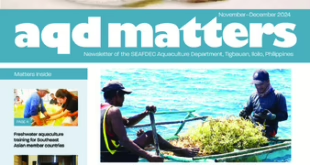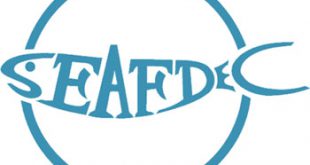 Technology Description
Technology Description
Brief description: Hatcheries are indispensable to grow-out operators especially when seedstock supply from the wild is not assured. For tiger shrimp, the technology can be relatively low-cost “backyard type” very popular among aquaculturists in the 1980s, or medium to large scale With fewer shrimp hatcheries continuing operations up to the present, the market potential is big. (Marketing is one of the problems of shrimp hatcheries. Since fewer ponds are stocked with shrimp due to disease threats/occurrence, demand for shrimp fry has also decreased).
To put-up a hatchery, an entrepreneur needs to decide on target production. For every million of postlarvae (day 15-20), a total tank volume of 80-100 tons is required.
This is based on these assumptions: (1) survival rate is 30-40% until harvest, (2) stocking density of 50,000 to 80,000 nauplii per ton, and (3) larval tanks are also used as nursery tanks. Spawners or broodstock are procured, ablated (for broodstock), and then left to spawn in tanks.
Feeding regime (formulated feeds can be given in combination with natural food), and water management are based on the developmental stages of shrimp, from egg hatching to nauplius stage, to protozoea, to mysis, then finally to the postlarval stage. PLs can be sold at day 15 to 20.
| Technology profile: | |
| (1) Procure healthy spawners that have late developing to ripe ovaries, and stock 1 spawner per 3 li of seawater. You will need 4-5 wild spawners or 7-8 pond-sourced broodstock for every million nauplii needed.
(2) Cover spawning tanks, aerate, monitor for spawning, and remove the spawners after spawning. Clean the tank of scum from tank sides and water surface. Alternatively, eggs may be siphoned out, rinsed several times with clean seawater, then re-stocked in clean tanks. Eggs hatch in 12-17 hours. (3) Collect nauplii by exposing a portion of the tank to light; nauplii will congregate there. Acclimate, then stock in 10-to-50- ton tanks with clean seawater. Natural food (Chaetoceros, Tetraselmis, or Skeletonema) should be in, or ready when nauplii metamorphose to its first feeding stage (protozoea) in 1.5-2 days. Chaetoceros could reach one million cells per ml after 1-2 days, Skeletonema 300,000 cells per ml in 2 days, and Tetraselmis 100,000 cells per ml in 3-5 days. Protozoea stage lasts 3-5 days, and then metamorphose to the mysis stage, and to the postlaval stage after another 3-5 days. (4) Continue feeding natural food, maintaining 20,000 to 50,000 phytoplankton cells per ml in tanks. Add Artemia to larval diet only in the mysis or postlarval stage (0.25 to 0.5 ind per ml), and/or feed a microparticulate diet based on a SEAFDEC/AQD formulation. Mysis stage lasts 6-7 days, and they become postlarvae. (5) Continue with the feeding regime, increasing Artemia feeding to 0.5 to 1 ind per ml until day 10, then to 1-2 ind per ml after that until harvest. (6) Replace 50% of total water volume beginning at the postlarval stage, then 50% daily thereafter. Use seawater disinfected with 5-10 ppm hypochlorite and neutralized with strong aeration and sodium thiosulfate, and treated with 5-10 ppm of EDTA. (7) Transfer PLs aged day 5 in nursery tanks where substrates have been installed. (8) Harvest when you have buyers at day 15 to 20. First lower the tank water to a third or fourth of its volume, scoop out the PLs and distribute in white basins, then pack 2000 to 2500 in each double-lined aerated plastic bag with water. Tie up and place in a bayong. |
|
References
Agbayani RF, Hatch U, Belleza E. 1995. Economic analysis of prawn (Penaeus monodon) culture in the Philippines, I: Hatchery operations. Asian Fisheries Science 8:191-200
Baticados MCL, Lavilla-Pitogo CR, Cruz-Lacierda ER, de la Peña LD, Suñaz NA. 1990. Studies on the chemical control of luminous bacteria Vibrio harveyi and V. splendidus isolated from diseased Penaeus monodon larvae and rearing water. Diseases of Aquatic Organisms 9:133-139
Baticados MCL, Pitogo CL. 1990. Chlorination of seawater used for shrimp culture. Israeli Journal of Aquaculture – Bamidgeh 42:128-130
Bautista MN, Parado-Estepa F, Millamena OM, Borlongan EL. 1991. Large scale hatchery production of Penaeus monodon using natural food and artificial diets. Israeli Journal of Aquaculture – Bamidgeh 43:137-144
Feed Development Section. 1994. Feeds and feeding of milkfish, Nile tilapia, Asian sea bass, and tiger shrimp. Aquaculture Extension Manual 21. SEAFDEC Aquaculture Department, Tigbauan, Iloilo. 97 p
Lavilla-Pitogo CR, Baticados MCL, Cruz-Lacierda ER, de la Peña LD. 1990. Occurrence of luminous bacterial disease of Penaeus monodon larvae in the Philippines. Aquaculture 91:1-13
Lavilla-Pitogo CR, Lio-Po GD, Cruz-Lacierda ER, Alapide-Tendencia EV, de la Pena LD. 2000. Diseases of penaeid shrimps in the Philippines. Aquaculture Extension Manual No. 16, 2nd edition; SEAFDEC Aquaculture Department, Tigbauan, Iloilo. 83 p
Parado-Estepa FD, Quinitio ET, Borlongan EL. 1996. Prawn hatchery operations. Aquaculture Extension Manual No. 19, SEAFDEC Aquaculture Department, Tigbauan, Iloilo. 45 p
Primavera JH. 1979. Notes on the courtship and mating behavior in Penaeus monodon Fabricius (Decapoda, Natantia). Crustaceana 37:287-292
Primavera JH. 1978. Induced maturation and spawning in five-month-old Penaeus monodon Fabricius by eyestalk ablation. Aquaculture 13:355-359
Primavera JH, Borlongan E, Posadas RA. 1978. Mass production in concrete tanks of sugpo Penaeus monodon Fabricius spawners by eyestalk ablation. Fisheries Research Journal of the Philippines 3:1-12
Santiago AC Jr. 1977. Successful spawning of cultured Penaeus monodon Fabricius after eyestalk ablation. Aquaculture 11:185-196
Tan-Fermin JD, Pudadera RA. 1989. Ovarian maturation stages of the wild giant tiger prawn, Penaeus monodon Fabricius. Aquaculture 77:229-242
Motoh H, Buri P. 1980. Early post mysis stages of the giant tiger prawn, Penaeus monodon Fabricius. Researches on Crustacea 10:13-34.
 SEAFDEC/AQD Southeast Asian Fisheries Development Center | Aquaculture Department
SEAFDEC/AQD Southeast Asian Fisheries Development Center | Aquaculture Department

